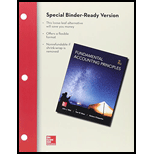
Requirement-1:
To calculate:
Requirement-1:
Answer to Problem 2BTN
Solution: Accounts receivable turnover for Apple and Google for each of the two most recent years is as follows:
| Apple | ||||
| Current Year | One year Prior | Current Year | One year Prior | |
| Accounts Receivable Turnover | 14.22 | 19.20 | 7.14 | 7.54 |
Explanation of Solution
Explanation: Accounts receivable turnover for Apple and Google for each of the two most recent years is calculated as follows:
| Apple | ||||
| ($ millions) | Current Year | One year Prior | Current Year | One year Prior |
| Net Sales (A) | $170,910 | $156,508 | $ 59,825 | $ 50,175 |
| Beginning Accounts Receivable (B) | $ 10,930 | $ 5,369 | $ 7,885 | $ 5,427 |
| Ending Accounts Receivable (C) | $ 13,102 | $ 10,930 | $ 8,882 | $ 7,885 |
| Average Accounts Receivable (D) =(B+C)/2 = | $ 12,016 | $ 8,150 | $ 8,384 | $ 6,656 |
| Accounts Receivable Turnover (E) = A/D = | 14.22 | 19.20 | 7.14 | 7.54 |
Conclusion: Accounts receivable turnover for Apple and Google for each of the two most recent years is as follows:
| Apple | ||||
| Current Year | One year Prior | Current Year | One year Prior | |
| Accounts Receivable Turnover | 14.22 | 19.20 | 7.14 | 7.54 |
Requirement-2:
To calculate: Average collection period or days sales in receivable for Apple and Google for each of the two most recent years and explanation for the difference in ratios
Requirement-2:
Answer to Problem 2BTN
Solution: Average collection period or days sales in receivable for Apple and Google for each of the two most recent years is as follows:
| Apple | ||||
| Current Year | One year Prior | Current Year | One year Prior | |
| Collection period (days) | 26 | 19 | 51 | 48 |
The difference in the ratios of two companies is due to difference in amount of sales receivable as compared with the sales.
Explanation of Solution
Explanation: Average collection period or days sales in receivable for Apple and Google for each of the two most recent years is explained as follows:
| Apple | ||||
| ($ millions) | Current Year | One year Prior | Current Year | One year Prior |
| Net Sales (A) | $170,910 | $156,508 | $ 59,825 | $ 50,175 |
| Beginning Accounts Receivable (B) | $ 10,930 | $ 5,369 | $ 7,885 | $ 5,427 |
| Ending Accounts Receivable (C) | $ 13,102 | $ 10,930 | $ 8,882 | $ 7,885 |
| Average Accounts Receivable (D) =(B+C)/2 = | $ 12,016 | $ 8,150 | $ 8,384 | $ 6,656 |
| Accounts Receivable Turnover (E) = A/D = | 14.22 | 19.20 | 7.14 | 7.54 |
| Collection period (days)= 365/E = | 26 | 19 | 51 | 48 |
Conclusion: The difference in the ratios of two companies is due to difference in amount of sales receivable as compared with the sales.
Requirement-3:
To indicate: the Company more efficient in collecting its accounts receivable
Requirement-3:
Answer to Problem 2BTN
Solution: Apple Company is more efficient in collecting its accounts receivable
Explanation of Solution
Explanation: Apple Company is more efficient in collecting its accounts receivable because it has lower collection period or says its sales remain uncollected for lesser number of days as compared with Google.
Conclusion: Hence, Apple Company is more efficient in collecting its accounts receivable
Want to see more full solutions like this?
Chapter 9 Solutions
Loose Leaf for Fundamentals of Accounting Principles and Connect Access Card

 AccountingAccountingISBN:9781337272094Author:WARREN, Carl S., Reeve, James M., Duchac, Jonathan E.Publisher:Cengage Learning,
AccountingAccountingISBN:9781337272094Author:WARREN, Carl S., Reeve, James M., Duchac, Jonathan E.Publisher:Cengage Learning, Accounting Information SystemsAccountingISBN:9781337619202Author:Hall, James A.Publisher:Cengage Learning,
Accounting Information SystemsAccountingISBN:9781337619202Author:Hall, James A.Publisher:Cengage Learning, Horngren's Cost Accounting: A Managerial Emphasis...AccountingISBN:9780134475585Author:Srikant M. Datar, Madhav V. RajanPublisher:PEARSON
Horngren's Cost Accounting: A Managerial Emphasis...AccountingISBN:9780134475585Author:Srikant M. Datar, Madhav V. RajanPublisher:PEARSON Intermediate AccountingAccountingISBN:9781259722660Author:J. David Spiceland, Mark W. Nelson, Wayne M ThomasPublisher:McGraw-Hill Education
Intermediate AccountingAccountingISBN:9781259722660Author:J. David Spiceland, Mark W. Nelson, Wayne M ThomasPublisher:McGraw-Hill Education Financial and Managerial AccountingAccountingISBN:9781259726705Author:John J Wild, Ken W. Shaw, Barbara Chiappetta Fundamental Accounting PrinciplesPublisher:McGraw-Hill Education
Financial and Managerial AccountingAccountingISBN:9781259726705Author:John J Wild, Ken W. Shaw, Barbara Chiappetta Fundamental Accounting PrinciplesPublisher:McGraw-Hill Education





